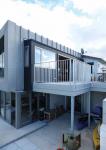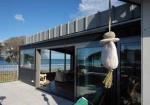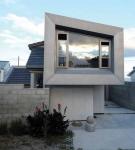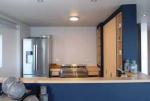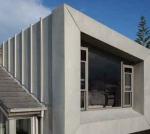A Bach Not A Beach House
Creating a relaxed environment for beachside holidays was the prime motivation for the owners of this Whangamata home. But they also wanted something that was architecturally interesting and displayed the materials and structure of the building.
As Glenn Bodger, of Strata Architects, says, “The owners of this home are probably the most creative clients that we have had. They wanted something that was a bit out there but they also wanted a bach not a beach house.”
The narrow, wedge-shaped beachfront site, which was subdivided from a cross-lease title, had strict planning controls but enjoys views over the sand dunes out to sea.
Glenn’s two-storey design involved creating a concrete block “plinth” on which the “carcass” of the upper floor sits and overhangs. The home has mono-pitched roof planes, and the view of the sea is framed with an angled picture window. As the section widens out from the street towards the beach, the home expands with it.
Glenn says his clients didn’t want a “precious home” that required lots of cleaning and maintenance.
“They wanted a different living experience to the one that they have at home, one that was easy and relaxed and where kids could come in with sand on their feet and the place could take a bit of knocking around. The idea is the place is loaded up with kayaks and bikes and when you get there you throw all that stuff out on the lawn.”
With that in mind, Glenn and his clients were looking for materials that were durable, would require minimal finishing and would speak for themselves.
Glenn says roofing and cladding were always going to play a big part in the look of the home so it was vital to find the right material.
“I wanted to do the roof in lead because I’ve been to France and seen that and like that matt grey look,” says Glenn. “Then David Peake [of Peake Construction and Roofing] told us about Terne Coated Stainless Steel and we saw it and fell in love with it. The great thing about the Terne is that is starts out with a silver satin finish, but as soon as it is exposed to the elements, it begins to weather to mimic the lead look, which ultimately colours to a rich grey patina. The beautiful grey patina blends in with the iconic block wall and the cement board. It is grey on grey on grey.”
The majority of the walls and roof planes of the house were wrapped in Independence Gray/TCS II Satin - Terne Coated Stainless Steel, a product new to New Zealand but one that has been used on high-profile buildings in Europe and the United States. The Roll Cap Eurostyle™ profile accentuates the building lines. Eurostyle™ is manufactured by Roofing Industries and available in seven roofing, cladding and panel profiles.
Glenn adds, “The nice thing about the Terne is that the joins are easily soldered and with the solder you can see the manmade elements there. Once it’s installed, you leave it to weather and it gets better with age.”
That philosophy applies to the whole house where robust materials have been used that can withstand the elements and the coastal environment but soften as they undergo a natural weathering process.
“Nothing on the house is painted,” says Glenn. “The block wall and the cement board have all been sealed but then they have just been left to weather.”
And the same applies inside where unvarnished timber had been used for ceiling and panelling, while the floors are polished concrete.
“The owner has been collecting tawa and kahikatea for years so that has all been used inside,” says Glenn.
The home has been designed to cater for up to three families with a bunkroom and garage that can be used for extra guests.
Even the garage door is a statement in itself, made from fibreglass sheets. “You can see the fibres in the door and the door is translucent so it glows at night when the light is on.”
Glenn says the downstairs is quite “utilitarian” with garage, storage, a laundry, bunkroom, bathrooms and two bedrooms. Upstairs are the living spaces and kitchen.
“It was quite a complicated build,” says Glenn. “There are seven different levels throughout the home, the spaces step down and around, all the rooms taper and nothing is square. The stairs start at 1100mm wide and at the top they open out to 1500mm wide.
“While it’s a really tight house there are areas where the ceiling is 4m high and other areas like the front door where it’s 2m high and you can feel the weight of the building.”
A feature of that entrance is the Terne cladding wrapping under to form a soffit over the entrance.
It’s just one of the design details that provided a huge challenge for David Peake, of Peake Construction and Roofing.
“The job itself was very technical as the building is not square – the lines of it run out of parallel to frame the sea views,” David says. “There are no square angles on it anywhere and that meant no two sheets were the same. The attention to detail was a bit mind-numbing at times but the result looks spectacular.”
Because the joins in the Terne sheets are soldered, David says he had to “re-learn how to solder and go out and buy some soldering equipment”.
He says other challenges they faced were detailing an internal gutter, picture frame flashing the large, angular windows and creating a ventilated ridge on the roof.
“The design required no ridge flashing on the high side so we had to create a ventilated ridge without showing any ridge flashing,” says David. “As there are no proprietary flashing details for a vented ridge that is unflashed, we created a detail in collaboration with the architect in order to achieve the look they wanted, while at the same time meeting the technical requirements for the product installation.”
The roofing was laid on a plywood substrate with Enka-Vent matting between the two to allow for venting and expansion.
David says it was the first time he had used Terne and he was impressed with it.
“As a material, it’s very similar to copper but lighter than copper and very soft and easy to work with,” he says. “We also did all the spoutings and downpipes in Terne and those were all soldered, too.”
Terne Coated Stainless Steel has been brought into the country by Auckland-based Ambro Metals Ltd. and manufactured by Roofing Industries in the stunning Eurostyle™ product.
Adrian Ward, of Ambro Metals, says that because the Whangamata home was the first to use the product in New Zealand, he had to vet aspects of the design and installation.
“My role was to make sure the material was installed properly not just for the sake of the product but for the sake of the home,” says Adrian.
“I supervised the job and educated the installers about the product because there are practical aspects to it that you can’t ignore such as breathability and allowing for expansion. It is also wise to use long lasting stainless steel fixings, not galvanized.”
Adrian says a proper installation was vital in the humid coastal environment of Whangamata.
“Convection currents under the roof need to be released because if a home can’t breathe sweating and deterioration may take place,” Adrian says. “The material also needs break points to allow for expansion and contraction.”
He says TCS II Satin - (Terne Coated Stainless Steel) has a proven track record as a durable and attractive architectural roofing and cladding material.
“It has been used on numerous buildings such as the London Opera House, various airports and schools; it’s got a long-standing history and it has never failed.
“It’s great to work with, solders beautifully and is more compatible with other construction materials we use.”
He says the Whangamata job was a challenging first assignment because of the detail involved in the design but the time spent nutting out every element of the installation paid dividends.
“Everyone involved loved the product and walked away with peace of mind that it was going to perform and last the distance as it should.”
What is Terne Coated Stainless Steel?
Produced by US-based Revere Copper Products Inc., Terne Coated Stainless Steel is a Type 304(non-magnetic) stainless steel suitable for roll-forming covered on both sides with Revere’s Z-T Alloy™ with amicro embossed finish. Revere Copper’s patented coating process applies a uniform thickness of minimum 12.7 microns to each side of the stainless steel substrate. The Z-T Alloy™ coated stainless steel is then passed through high-pressure rollers resulting in a micro embossed low glare, satin finish. The Z-T Alloy™ Coating is oxygen reactive and weathers to form an attractive rich earth tone grey patina. The coating provides outstanding resistance against severely corrosive atmospheres, including those encountered in chemically polluted, chlorine laden, and marine environments. The first Terne Coated roofing products were produced in the 1800s, by a company that eventually became the Follansbee Steel Corporation. In 2012 Follansbee Steel Corporation was purchased by Revere Copper, the oldest manufacturing company in the USA. Revere Copper have built a new Revere Z-T™ Alloy coating line with many improvements over the previous already successful manufacturing process. This material is now available in New Zealand exclusively from Ambro Metals.

